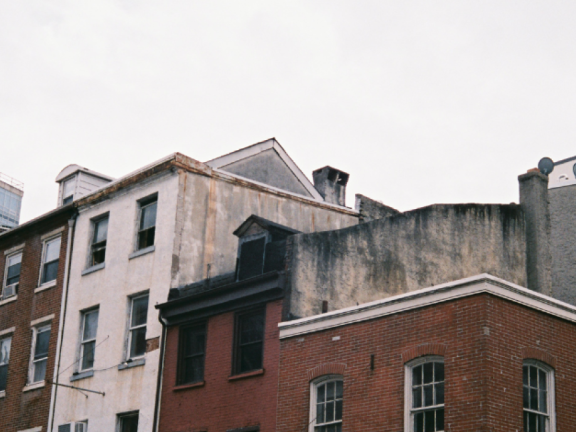Looking at Overcrowded Homes

What is overcrowding?
Strolling down the streets of Philadelphia, it is easy to pass by a row of houses and not see much of a difference from one to the next. But trying to guess what lies behind the brick walls is a bit more difficult. Just how many people are living in a given home? Could it be a group of eight 20-year-olds scraping by, a settled family of four, or an extended family all living together?
There is no clear definition or quantification for overcrowding - or how many people are too many within a home. According to Philadelphia’s Home Rule Charter, “The number of persons occupying a dwelling unit shall not create conditions that…endanger the life, health, safety or welfare of the occupants.”i The Department of Housing and Urban Development (HUD) has established a standard for overcrowding as “more than one person-per-room.”ii Whereas, the Urban Institute has considered different measurements, including more than 2 people for every bedroom or less than 165 square feet of housing per personiii. While the debate goes on, it is clear that overcrowding can be characterized by a lack of privacy and space to oneself.
Overcrowded households can be found primarily in cities, particularly in areas with a greater number of low-income renters. Historically, a greater share of Black and Hispanic households have experienced overcrowdingiv. More specifically, immigrants and foreign-born individuals are more likely to live in overcrowded homesv. Figure 1 demonstrates how over the years overcrowding has only been growing, especially since the 2008 housing market crashvi. However, given its often hidden practice, the impacts of overcrowding are not always obvious.
Why does overcrowding occur?
In looking at its causes, it can be common to credit overcrowding to cultural values as opposed to socioeconomic factors. For instance, while some Hispanic cultures may value family closeness, this does not necessarily mean that these households are comfortable with a lack of privacy, space, and boundaries. Attributing overcrowding as a ‘cultural thing’ fails to see the effects of unaffordable housing, low wages, and ethnic and racial discrimination - factors of which restrict families of color from gaining healthy and stable housingvii.
The fact that most overcrowded households are rented is also telling. Black and Brown residents have been systematically refused access to homeownership, not only in the past but still to this day. While exclusion to homeownership may come in different murky forms, such as the systemic denial of bank loans or an unwillingness among realtors to show houses in predominantly white neighborhoods, it is clear that these efforts have left residents of color with less options and space to occupy. Moreover, when overcrowding is mistaken as a choice, it is also thought that families choose to take on the risks that come with residing with multiple people in smaller spaces.
What are the risks of overcrowding?
For one, overcrowding presents a burden to children whose education and development may be compromised due to their demanding living conditionsviii. Children may not be able to complete their homework when there is a lack of workspace or if there are distracting siblings nearby. Residing in close quarters also means that kids cannot remove themselves from the lives of their parents or other adults. As a result, children may be more exposed to parental arguments or stressful conversations. All in all, the lack of space between kids and their caretakers can bring about tension to both parties and place strains on their relationships. These are adults who may already be struggling financially and without the proper space and time to decompress, may be suffering mental distress as well.
The health effects of overcrowding have been evident throughout the pandemic. Overcrowded households are more vulnerable to COVID-19; if only one person falls ill, they have less room to isolate and stop the spread to other residents. This vulnerability is exacerbated by the fact that about 40% of Black and Hispanic households have at least one person who works a high-proximity job that increases the risk of COVID exposureix. So, not only are more people of color working high contact jobs, they may also be coming home to more people who often range from young kids to grandparents. The health effects of overcrowding are also not limited to COVID; households with more people and less space are left vulnerable to respiratory and infectious diseases, such as asthma and the flux.
Finally, with overcrowding comes the possibility of eviction, propelling the cycle of homelessness. Cities like Philadelphia have occupancy limits - or restrictions on how many people can live within a certain amount of space - and rules against sleeping in “kitchens and nonhabitable spaces”xi. Landlords may be willing to turn a blind eye to these ordinances in return for more rent under the table. However, households are the ones bearing the risk of eviction if they or their landlords are caught violating local ordinances. But even when a household is not evicted, they are living in a state of invisibility. Landlords may choose to deny the rights of unaccounted tenants. In turn, residents cannot easily reach out to law enforcement when they are being treated unfairlyxii. Such a suppression of human rights is further exacerbated when an individual is an undocumented immigrant. Finally, living off the books means that these occupants go uncounted, whether that is in terms of the census or in the form of social benefits that require proof of residence.
What does all of this mean?
The unseen struggles of those living in overcrowded households means that they tend to go by unaddressed. Rather than tackle root causes, local legislatures have frequently wielded strategies that discourage households from doubling up. Cities have made occupancy violations more punitive and used zoning to prevent the development of houses with multiple residential unitsxiii. Overcrowding in neighborhoods where only one-family homes are allowed can foster scrutiny and conflict between neighborsxiv. Through seemingly-neutral policies, cities have created more divided neighborhoods based on race and ethnicity. Ultimately, these efforts push communities of color out and denies them access to economic opportunities and overall stability. Given the observation that overcrowding tends to rise during economic crises, such as the Great Recession, it is crucial more than ever to provide support towards equitable and affordable housing before overcrowded homes turn into evicted homes.
__________________________________________________
iPhiladelphia Charter Commission. “Philadelphia Home Rule Charter.” American Legal Publishing Corporation, June 10, 2022, https://codelibrary.amlegal.com/codes/philadelphia/latest/philadelphia_…. PM-404.5.
iiU.S. Department of Housing and Urban Development. “Measuring Overcrowding in Housing,” U.S. Federal Government. September 2007. https://www.huduser.gov/publications/pdf/measuring_overcrowding_in_hsg…. p.12.
iiiCunningham, Mary et al. ”Improving Measures of Housing Insecurity: A Path Forward.” The Urban Institute. November 23, 2016. https://www.urban.org/research/publication/improving-measures-housing-i…. p.7.
ivU.S. Department of Housing and Urban Development. p.15.
vRoth, Benjamin J. ”Bajo el Mismo Techo: The Latino Communist in Suburban Chicago: An analysis of Overcrowded Housing.” Latinos United. February 2008. https://www.latinopolicyforum.org/resources/document/LU_Crowding_Report…. p.4.
viSolari, Claudia D. “America’s Housing is Getting More Crowded. How Will That Affect Children?” Urban Institute. April 24, 2019. https://www.urban.org/urban-wire/americas-housing-getting-more-crowded-…. Figure 1.
viiRoth, Benjamin J. pp.12-13.
viiiSolari, Claudia D.
ixAirgood-Obrycki, Whitney. ”High-Proximity Jobs and Household Vulnerabilities.” Joint Center for Housing Studies of Harvard University. June 8, 2020. https://www.jchs.harvard.edu/blog/high-proximity-jobs-and-household-vul….
xGanesh, Bhargavi et al. “The Relationship between Housing and Asthma among School-Age Children: Analysis of the 2015 American Housing Survey.” Urban Institute. October 2017. https://www.urban.org/sites/default/files/publication/93881/the-relatio…. p.19.
xiPhiladelphia Charter Commission. PM-404.4.4.
xiiCurbed. ”Basic tenant rights in Philly, explained.” Curbed. September 16, 2019. https://philly.curbed.com/2017/6/14/15758672/tenant-rights-philadelphia…
xiiiRoth, p.23.
xivIbid, p.23.


